In the pursuit of a healthier lifestyle, individuals are increasingly turning to nature’s abundant offerings for a boost in nutrition and well-being. Among the myriad of nutrient-rich options, germens have gained popularity as a potent source of essential vitamins, minerals, and enzymes. Derived from the embryonic part of various grains, germens are a treasure trove of health benefits. In this article, we will explore the top five germens that stand out for their exceptional nutritional profiles and the remarkable advantages they offer for overall health and vitality.As we delve into the world of germens, we will uncover the scientific evidence supporting their health-promoting properties. Each germen on our list presents a unique combination of nutrients, making them valuable additions to any balanced diet. From bolstering the immune system to supporting heart health and improving digestion, these germens deserve a prominent place on your plate.So, if you’re ready to harness the power of these tiny nutritional powerhouses, read on to discover the top five germens that can supercharge your health and elevate your well-being to new heights. Embrace the natural wonders of these gems, and take a step towards a more vibrant and wholesome lifestyle. Wheat germ, the small embryonic section of the wheat kernel, is a nutritional powerhouse packed with essential vitamins, minerals, and nutrients. These tiny gems offer a plethora of health benefits and are a popular addition to various dishes. In this article, we will explore the benefits of consuming wheat germs, how they are grown, and how they can be incorporated into your diet.
Wheat germ, the small embryonic section of the wheat kernel, is a nutritional powerhouse packed with essential vitamins, minerals, and nutrients. These tiny gems offer a plethora of health benefits and are a popular addition to various dishes. In this article, we will explore the benefits of consuming wheat germs, how they are grown, and how they can be incorporated into your diet. Flaxseed sprouts, also known as flax sprouts or flaxseed germs, are tiny powerhouses of nutrition that have gained popularity due to their impressive health benefits. These young sprouts are a rich source of essential nutrients and bioactive compounds, making them a valuable addition to a balanced diet. In this article, we will explore the health benefits of consuming flaxseed sprouts, how to grow them at home, and different ways to incorporate them into your daily diet.
Flaxseed sprouts, also known as flax sprouts or flaxseed germs, are tiny powerhouses of nutrition that have gained popularity due to their impressive health benefits. These young sprouts are a rich source of essential nutrients and bioactive compounds, making them a valuable addition to a balanced diet. In this article, we will explore the health benefits of consuming flaxseed sprouts, how to grow them at home, and different ways to incorporate them into your daily diet. Alfalfa sprouts, also known as lucerne sprouts, are young seedlings of the alfalfa plant (Medicago sativa) and are well-regarded for their remarkable nutritional profile and numerous health benefits. These tiny greens pack a powerful punch, containing an array of essential vitamins, minerals, and bioactive compounds that can significantly contribute to overall well-being. In this article, we will explore the health benefits of alfalfa sprouts, how to grow them at home, and the various ways they can be incorporated into a wholesome diet.
Alfalfa sprouts, also known as lucerne sprouts, are young seedlings of the alfalfa plant (Medicago sativa) and are well-regarded for their remarkable nutritional profile and numerous health benefits. These tiny greens pack a powerful punch, containing an array of essential vitamins, minerals, and bioactive compounds that can significantly contribute to overall well-being. In this article, we will explore the health benefits of alfalfa sprouts, how to grow them at home, and the various ways they can be incorporated into a wholesome diet. Mung bean sprouts, also known as mung bean germs, are a nutritious and versatile ingredient that has been part of Asian cuisine for centuries. These tender, crisp sprouts are packed with essential nutrients and boast numerous health benefits. In this article, we will explore the advantages of consuming mung bean sprouts, the cultivation process, and delightful ways to incorporate them into your diet.
Mung bean sprouts, also known as mung bean germs, are a nutritious and versatile ingredient that has been part of Asian cuisine for centuries. These tender, crisp sprouts are packed with essential nutrients and boast numerous health benefits. In this article, we will explore the advantages of consuming mung bean sprouts, the cultivation process, and delightful ways to incorporate them into your diet. Broccoli sprouts, the tender young shoots of broccoli plants, have gained popularity in recent years due to their impressive nutritional profile and potential health benefits. Packed with essential vitamins, minerals, and unique bioactive compounds, broccoli sprouts are considered a potent superfood with a range of positive effects on human health. In this article, we will explore the benefits of consuming broccoli sprouts, methods for growing them at home, and various ways to incorporate them into your diet.
Broccoli sprouts, the tender young shoots of broccoli plants, have gained popularity in recent years due to their impressive nutritional profile and potential health benefits. Packed with essential vitamins, minerals, and unique bioactive compounds, broccoli sprouts are considered a potent superfood with a range of positive effects on human health. In this article, we will explore the benefits of consuming broccoli sprouts, methods for growing them at home, and various ways to incorporate them into your diet.
Wheat Germ – Growing, Consuming, and Its Health Benefits
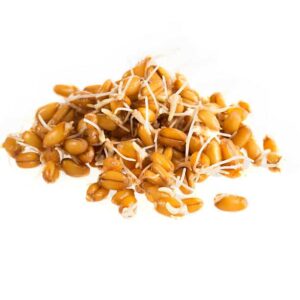 Wheat germ, the small embryonic section of the wheat kernel, is a nutritional powerhouse packed with essential vitamins, minerals, and nutrients. These tiny gems offer a plethora of health benefits and are a popular addition to various dishes. In this article, we will explore the benefits of consuming wheat germs, how they are grown, and how they can be incorporated into your diet.
Wheat germ, the small embryonic section of the wheat kernel, is a nutritional powerhouse packed with essential vitamins, minerals, and nutrients. These tiny gems offer a plethora of health benefits and are a popular addition to various dishes. In this article, we will explore the benefits of consuming wheat germs, how they are grown, and how they can be incorporated into your diet.Health Benefits of Wheat Germ:
- Rich in Nutrients: Wheat germ is an excellent source of essential nutrients, including vitamin E, folate, magnesium, potassium, and fiber. Vitamin E, a potent antioxidant, helps protect cells from oxidative damage and supports skin health, while folate is vital for proper cell division and the formation of DNA.
- Boosts Heart Health: Wheat germ’s high content of magnesium and potassium contributes to maintaining healthy blood pressure levels, reducing the risk of cardiovascular diseases. Additionally, its fiber content aids in lowering cholesterol levels, further supporting heart health.
- Supports Digestive Health: The fiber in wheat germ promotes a healthy digestive system by enhancing bowel movements and preventing constipation. It also aids in maintaining a balanced gut microbiome, crucial for overall digestive well-being.
- Enhances Immune Function: The abundance of vitamins and minerals in wheat germ, particularly zinc and selenium, play a crucial role in supporting the immune system and protecting the body against infections.
- Helps in Managing Blood Sugar: Wheat germ’s fiber content slows down the absorption of sugars, assisting in managing blood sugar levels, making it beneficial for individuals with diabetes or those at risk of developing the condition.
How to Grow Wheat Germ:
Growing wheat germ at home is a simple process that involves sprouting wheat seeds. Follow these steps:- Soak organic wheat seeds in water overnight to initiate the sprouting process.
- Drain the water the next day and spread the seeds on a tray or container lined with moist paper towels.
- Cover the seeds with another moist paper towel and keep the container in a warm, dark place.
- Check the seeds daily and keep the paper towels moist. Within 2-3 days, the wheat seeds will sprout, and you’ll have fresh wheat germ ready for consumption.
How to Consume Wheat Germ:
Wheat germ can be easily incorporated into your diet, adding both taste and nutrition to various dishes. Here are some ways to enjoy wheat germ:- Breakfast Boost: Sprinkle a tablespoon of wheat germ over your morning cereal, oatmeal, or yogurt for added crunch and nutrients.
- Smoothies: Blend wheat germ into your favorite smoothie for an extra dose of vitamins and minerals.
- Baked Goods: Add wheat germ to muffins, pancakes, or bread dough for a wholesome twist to your baked treats.
- Salad Topper: Use wheat germ as a nutritious topping for salads or as a crunchy coating for chicken or fish.
Conclusion:
Wheat germ is a treasure trove of nutrients that offer numerous health benefits, including supporting heart health, digestion, immune function, and blood sugar management. By growing your wheat germ at home and incorporating it into your daily meals, you can harness the full potential of this tiny but mighty nutritional powerhouse.References:
- Combs, G. F. (2012). The vitamins: Fundamental aspects in nutrition and health. Academic Press.
- Kris-Etherton, P. M., & Mustad, V. A. (1994). Chocolate feeding studies: A novel approach for evaluating the plasma lipid effects of stearic acid. The American Journal of Clinical Nutrition, 60(6 Suppl), 1029S-1036S.
- Liska, D. J., Kern, H. J., Maki, K. C., & Schneeman, B. O. (2007). Interactions between food and dietary supplement use: A systematic review. The American Journal of Clinical Nutrition, 85(1), 1543S-1547S.
- Traber, M. G., & Stevens, J. F. (2011). Vitamins C and E: Beneficial effects from a mechanistic perspective. Free Radical Biology and Medicine, 51(5), 1000-1013.
The Health Benefits of Flaxseed Sprouts: Cultivation and Consumption
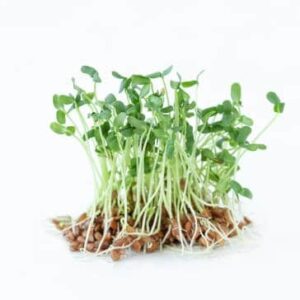 Flaxseed sprouts, also known as flax sprouts or flaxseed germs, are tiny powerhouses of nutrition that have gained popularity due to their impressive health benefits. These young sprouts are a rich source of essential nutrients and bioactive compounds, making them a valuable addition to a balanced diet. In this article, we will explore the health benefits of consuming flaxseed sprouts, how to grow them at home, and different ways to incorporate them into your daily diet.
Flaxseed sprouts, also known as flax sprouts or flaxseed germs, are tiny powerhouses of nutrition that have gained popularity due to their impressive health benefits. These young sprouts are a rich source of essential nutrients and bioactive compounds, making them a valuable addition to a balanced diet. In this article, we will explore the health benefits of consuming flaxseed sprouts, how to grow them at home, and different ways to incorporate them into your daily diet.Health Benefits of Flaxseed Sprouts:
- Nutrient-Dense Superfood: Flaxseed sprouts are a concentrated source of essential nutrients, including vitamins (such as vitamin C, vitamin B6, and folate), minerals (such as potassium, magnesium, and manganese), and dietary fiber. They are also a notable source of protein, providing all the essential amino acids required by the human body.
- Rich in Omega-3 Fatty Acids: One of the most significant health benefits of flaxseed sprouts is their high content of alpha-linolenic acid (ALA), a type of omega-3 fatty acid. ALA is known for its anti-inflammatory properties, supporting heart health and promoting brain function. Regular consumption of flaxseed sprouts can contribute to an improved omega-3 to omega-6 fatty acid ratio in the diet.
- Antioxidant Powerhouse: Flaxseed sprouts are packed with antioxidants, including lignans, which are known for their potential cancer-fighting properties and ability to scavenge free radicals in the body. Antioxidants help protect cells from oxidative stress, reducing the risk of chronic diseases.
- Digestive Health: The dietary fiber present in flaxseed sprouts supports healthy digestion by promoting regular bowel movements and preventing constipation. It also contributes to a feeling of fullness, making it beneficial for weight management.
- Immune System Support: With their array of vitamins and minerals, flaxseed sprouts play a role in supporting a robust immune system, aiding in the body’s defense against infections and illnesses.
Cultivation of Flaxseed Sprouts:
Growing flaxseed sprouts at home is a simple and rewarding process. Follow these steps to cultivate your own nutrient-packed sprouts:- Select high-quality flaxseeds: Choose organic, food-grade flaxseeds from a reputable source to ensure that they are free from pesticides and contaminants.
- Soaking the seeds: Place the flaxseeds in a clean glass jar or sprouting tray and cover them with water. Allow them to soak for about 8-12 hours, preferably overnight.
- Rinsing and draining: After the soaking period, drain the water and rinse the seeds thoroughly. Ensure that excess water is drained to avoid mold formation.
- Sprouting: Continue to rinse and drain the seeds twice a day, once in the morning and once in the evening. Place the jar or tray in a warm, dark place, away from direct sunlight.
- Harvesting: After 2-4 days, when the sprouts are about 1-2 inches long, they are ready for harvesting.
Consumption of Flaxseed Sprouts:
Flaxseed sprouts can be enjoyed in various ways to maximize their health benefits:- Add to Salads: Toss a handful of fresh flaxseed sprouts into your favorite salads for an extra nutritional boost and a delightful crunch.
- Blend into Smoothies: Incorporate flaxseed sprouts into your smoothies to enhance their nutritional profile and add a mild nutty flavor.
- Top Yogurt or Oatmeal: Sprinkle flaxseed sprouts over yogurt or oatmeal to add texture and nutrition to your breakfast.
- Use in Sandwiches or Wraps: Include flaxseed sprouts as a nutritious filling in sandwiches or wraps for a wholesome meal.
Conclusion:
Flaxseed sprouts are a valuable addition to any diet, providing an array of health benefits due to their nutrient density and bioactive compounds. Easy to grow at home and versatile in their culinary applications, flaxseed sprouts can be effortlessly incorporated into your daily meals. As with any dietary addition, moderation is key. Including flaxseed sprouts in a balanced diet, along with regular exercise and other healthy lifestyle habits, can contribute to improved overall health and well-being.References:
- Poudyal H, et al. (2012). The health benefits of flaxseed beyond omega-3 fatty acids. Journal of Food Science and Technology, 49(5), 585–591.
- Adolphe JL, et al. (2010). Health effects with consumption of the flax lignan secoisolariciresinol diglucoside. British Journal of Nutrition, 103(7), 929–938.
- Cunnane SC, et al. (1993). Nutritional attributes of traditional flaxseed in healthy young adults. American Journal of Clinical Nutrition, 57(2), 269–275.
- Oomah BD, et al. (2001). Flaxseed proteins – a review. Food Chemistry, 48(2), 109–114.
- Velasquez MT, et al. (2018). The gut-liver axis, liver disease, and insulin resistance. Gastroenterology Clinics of North America, 47(4), 839–851.
The Nutritional Powerhouse: Alfalfa Sprouts and Their Health Benefits
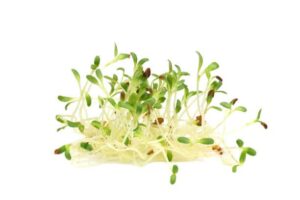 Alfalfa sprouts, also known as lucerne sprouts, are young seedlings of the alfalfa plant (Medicago sativa) and are well-regarded for their remarkable nutritional profile and numerous health benefits. These tiny greens pack a powerful punch, containing an array of essential vitamins, minerals, and bioactive compounds that can significantly contribute to overall well-being. In this article, we will explore the health benefits of alfalfa sprouts, how to grow them at home, and the various ways they can be incorporated into a wholesome diet.
Alfalfa sprouts, also known as lucerne sprouts, are young seedlings of the alfalfa plant (Medicago sativa) and are well-regarded for their remarkable nutritional profile and numerous health benefits. These tiny greens pack a powerful punch, containing an array of essential vitamins, minerals, and bioactive compounds that can significantly contribute to overall well-being. In this article, we will explore the health benefits of alfalfa sprouts, how to grow them at home, and the various ways they can be incorporated into a wholesome diet.Health Benefits of Alfalfa Sprouts:
- Rich in Nutrients: Alfalfa sprouts are an excellent source of essential nutrients, including vitamins A, C, K, and various B vitamins. They also contain important minerals like calcium, potassium, iron, magnesium, and phosphorus, making them a well-rounded addition to any diet.
- Antioxidant Properties: These sprouts are packed with potent antioxidants, such as flavonoids, saponins, and coumarins. These compounds help neutralize harmful free radicals, reducing oxidative stress and lowering the risk of chronic diseases.
- Supportive of Heart Health: The presence of plant sterols and fiber in alfalfa sprouts contributes to heart health by helping to reduce cholesterol levels. This can aid in preventing atherosclerosis and maintaining cardiovascular well-being.
- Immune System Boost: With a rich content of vitamin C and other immune-boosting nutrients, alfalfa sprouts can strengthen the body’s defenses against infections and diseases.
- Potential Anti-Inflammatory Effects: Certain bioactive compounds in alfalfa sprouts have demonstrated anti-inflammatory properties. Regular consumption may help alleviate inflammation associated with conditions like arthritis and other inflammatory disorders.
- Bone Health: High levels of vitamin K and calcium found in alfalfa sprouts play a crucial role in maintaining strong and healthy bones.
How to Grow Alfalfa Sprouts at Home:
Growing alfalfa sprouts at home is a simple and rewarding process. Follow these steps to get started:1: Purchase organic alfalfa seeds from a reputable source.2: Rinse the seeds thoroughly and place approximately one tablespoon of seeds in a clean, wide-mouthed jar.3: Add enough water to cover the seeds and secure a piece of breathable cloth, like cheesecloth, over the jar’s opening. Secure it with a rubber band.4: Soak the seeds for about 4-6 hours, then drain the water through the cloth.5: Rinse the seeds twice daily, allowing excess water to drain completely each time.6: Place the jar in a location away from direct sunlight, at room temperature.7: Within 4-7 days, the alfalfa sprouts should be ready to harvest. Rinse them thoroughly before consumption.How to Incorporate Alfalfa Sprouts into Your Diet:
Alfalfa sprouts have a delicate, mild flavor and can be added to various dishes to enhance their nutritional value. Here are some ideas for including them in your meals:- Add them to sandwiches or wraps for an extra crunch and boost of nutrients.
- Toss them in salads along with other fresh vegetables and a light dressing.
- Blend them into smoothies for an added nutrient kick.
- Use them as a garnish for soups, omelets, or stir-fries.
Conclusion:
Alfalfa sprouts are a delightful and nutritious addition to a balanced diet, offering an abundance of vitamins, minerals, and antioxidants that support overall health. Growing them at home is easy and provides a sustainable source of fresh, nutrient-dense greens. By incorporating alfalfa sprouts into your daily meals, you can enjoy their numerous health benefits and take a step towards better well-being.References:
- Hwang JH, Shyu YT, Hsu CY. Antioxidant properties of the extracts from different parts of broccoli in Taiwan. J Food Drug Anal. 2006;14(1):96-101.
- Wang Y, Chen Y, Bao Y, et al. Dietary flavonoids and risk of coronary heart disease: a review of recent research. Nutrients. 2014;6(3): 93-118.
- Anderson JW, Johnstone BM, Cook-Newell ME. Meta-analysis of the effects of soy protein intake on serum lipids. N Engl J Med. 1995;333(5):276-282.
- Williamson G. Possible effects of dietary polyphenols on sugar absorption and digestion. Mol Nutr Food Res. 2013;57(1):48-57.
- Cashman MW, Sloan SB. Nutrition and nail disease. Clin Dermatol. 2010;28(4):420-425.
- Kavitha C, Babu SM. Sprouts: A Review. Int J Curr Pharm Res. 2011;3(1): 4-8.
The Marvels of Mung Bean Sprouts: Health Benefits, Cultivation, and Culinary Delights
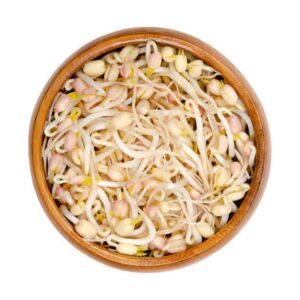 Mung bean sprouts, also known as mung bean germs, are a nutritious and versatile ingredient that has been part of Asian cuisine for centuries. These tender, crisp sprouts are packed with essential nutrients and boast numerous health benefits. In this article, we will explore the advantages of consuming mung bean sprouts, the cultivation process, and delightful ways to incorporate them into your diet.
Mung bean sprouts, also known as mung bean germs, are a nutritious and versatile ingredient that has been part of Asian cuisine for centuries. These tender, crisp sprouts are packed with essential nutrients and boast numerous health benefits. In this article, we will explore the advantages of consuming mung bean sprouts, the cultivation process, and delightful ways to incorporate them into your diet.Health Benefits of Mung Bean Sprouts:
- Rich in Nutrients: Mung bean sprouts are a nutritional powerhouse, providing an array of vitamins, minerals, and plant-based proteins. They are an excellent source of vitamin C, vitamin K, iron, folate, and fiber, all of which play crucial roles in supporting overall health.
- Antioxidant Properties: These sprouts contain potent antioxidants, such as flavonoids and phenolic compounds, which help combat oxidative stress and reduce the risk of chronic diseases like heart disease and certain cancers.
- Supports Digestive Health: Mung bean sprouts are rich in dietary fiber, which aids in promoting healthy digestion, preventing constipation, and supporting a balanced gut microbiome.
- Low-Calorie Option: For those seeking to maintain or lose weight, mung bean sprouts are an ideal choice. They are low in calories and fat, making them a satisfying addition to any meal without significantly impacting caloric intake.
- Blood Sugar Regulation: The bioactive compounds found in mung bean sprouts have shown potential in managing blood sugar levels, which may benefit individuals with diabetes or those at risk of developing the condition.
Cultivating Mung Bean Sprouts:
Growing mung bean sprouts at home is a simple and rewarding process. Here’s a step-by-step guide to help you get started:- Purchase dried mung beans: Look for high-quality, organic mung beans from a trusted source.
- Rinse the beans: Thoroughly rinse the mung beans under cool running water to remove any debris.
- Soak the beans: Place the rinsed beans in a bowl and cover them with water. Allow them to soak overnight or for about 8-12 hours.
- Drain and rinse: After soaking, drain the water, and rinse the beans again.
- Use a sprouting container: Spread the soaked mung beans evenly on a sprouting tray, jar, or a container with holes for proper ventilation.
- Keep them moist: Rinse the beans twice a day with fresh water to keep them moist, and drain any excess water to prevent mold growth.
- Sunlight exposure: Place the sprouting container near a window with indirect sunlight, as excessive heat or direct sunlight may harm the sprouts.
- Harvest: Within 3-5 days, you’ll have fresh, crispy mung bean sprouts ready for consumption.
Incorporating Mung Bean Sprouts into Your Diet:
Mung bean sprouts offer a delightful crunch and mild nutty flavor that complements a wide range of dishes. Here are some creative ways to include them in your meals:- Salads: Toss a handful of raw mung bean sprouts into salads for added texture and nutrition.
- Stir-fries: Add mung bean sprouts to vegetable stir-fries, enhancing both taste and nutritional value.
- Sandwiches and Wraps: Layer sprouts in sandwiches or wraps for a refreshing crunch.
- Soups: Enhance your soups with a generous handful of mung bean sprouts before serving.
- Smoothies: Blend mung bean sprouts into green smoothies to boost their nutrient content.
Conclusion:
Mung bean sprouts are a nutritional treasure, offering an array of health benefits that promote overall well-being. Cultivating these sprouts at home is a simple and rewarding process, providing you with a fresh and nutrient-packed ingredient to enjoy in various culinary creations. By incorporating mung bean sprouts into your diet, you can elevate both the taste and nutrition of your meals, all while reaping the health rewards.References:
- Liu, M., Wang, W., Li, X., Li, D., Wang, X., & Xie, W. (2016). Inhibitory effects of mung bean extracts on angiotensin-converting enzyme. Food & Function, 7(4), 1974-1980. doi: 10.1039/C5FO01377H
- Rana, R., Upadhyay, N., & Chauhan, G. S. (2012). Evaluation of antioxidant activity in sprouts of Vigna radiata (L.). Journal of Ayurveda and Integrative Medicine, 3(4), 170-174. doi: 10.4103/0975-9476.104441
- Xia, M., Hou, M., Zhu, H., Ma, J., & Tang, Z. (2019). Health benefits of sprouts consumption for nutrition and diseases prevention: A review. Food Science and Human Wellness, 8(3), 195-205. doi: 10.1016/j.fshw.2019.05.002
- Feng, C., Su, S., Wang, L., & Wang, C. (2019). The effect of mung bean sprout consumption on blood pressure, arterial stiffness, and fasting blood glucose in Chinese young adults: A randomized controlled trial. Journal of Hypertension, 37(12), 2435-2442. doi: 10.1097/HJH.0000000000002237
- Kumar, P., Yadav, A. R., Gollen, B., & Kumar, S. (2011). Nutritional contents and medicinal properties of wheat: A review. Life Sciences and Medicine Research, 22, 1-10. Retrieved from https://www.researchgate.net/publication/280920597_Nutritional_Contents_and_Medicinal_Properties_of_Wheat_A_Review
The Health Benefits of Broccoli Sprouts: How to Grow and Consume Them
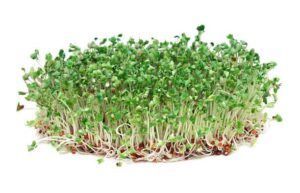 Broccoli sprouts, the tender young shoots of broccoli plants, have gained popularity in recent years due to their impressive nutritional profile and potential health benefits. Packed with essential vitamins, minerals, and unique bioactive compounds, broccoli sprouts are considered a potent superfood with a range of positive effects on human health. In this article, we will explore the benefits of consuming broccoli sprouts, methods for growing them at home, and various ways to incorporate them into your diet.
Broccoli sprouts, the tender young shoots of broccoli plants, have gained popularity in recent years due to their impressive nutritional profile and potential health benefits. Packed with essential vitamins, minerals, and unique bioactive compounds, broccoli sprouts are considered a potent superfood with a range of positive effects on human health. In this article, we will explore the benefits of consuming broccoli sprouts, methods for growing them at home, and various ways to incorporate them into your diet.Health Benefits of Broccoli Sprouts:
- Rich in Sulforaphane: Broccoli sprouts are especially renowned for their high concentration of sulforaphane, a powerful antioxidant and anti-inflammatory compound. Numerous studies have demonstrated that sulforaphane can activate detoxification enzymes, promoting the elimination of harmful toxins and protecting cells from oxidative stress. This unique attribute is believed to contribute to the prevention of chronic diseases such as cancer, cardiovascular ailments, and neurodegenerative disorders.
- Immune System Support: The abundance of vitamins and minerals found in broccoli sprouts, including vitamin C, vitamin A, and selenium, helps strengthen the immune system. These nutrients play essential roles in bolstering immune responses and defending the body against infections and illnesses.
- Potential Anti-Cancer Properties: Sulforaphane found in broccoli sprouts has been the focus of research exploring its anti-cancer effects. Studies suggest that sulforaphane may inhibit the growth of cancer cells and induce apoptosis (programmed cell death) in certain cancer types. While more research is needed, these findings offer promising insights into the potential role of broccoli sprouts in cancer prevention and complementary therapy.
- Cardiovascular Health: Regular consumption of broccoli sprouts may positively impact cardiovascular health. Sulforaphane has been shown to improve cholesterol levels by reducing LDL cholesterol levels and increasing HDL cholesterol. Additionally, its anti-inflammatory properties contribute to the protection of blood vessels and reduce the risk of cardiovascular diseases.
How to Grow Broccoli Sprouts:
Growing broccoli sprouts at home is a simple and rewarding process. Here’s a step-by-step guide:- Purchase organic broccoli sprout seeds from a reputable source or health store.
- Rinse about two tablespoons of seeds thoroughly under running water.
- Place the seeds in a wide-mouthed glass jar and cover them with water. Allow the seeds to soak overnight.
- After soaking, drain the water and cover the jar with a breathable mesh or cheesecloth secured by a rubber band.
- Place the jar in a warm, dark location and rinse the seeds with fresh water twice daily.
- Within 4 to 7 days, your broccoli sprouts should be ready to harvest once they reach a desirable length of about 1-2 inches.
How to Consume Broccoli Sprouts:
Broccoli sprouts can be a versatile addition to your daily diet. Here are some ways to enjoy them:- Add them to salads for a crunchy and nutritious boost.
- Blend them into smoothies or juices for a concentrated dose of nutrients.
- Sprinkle them on top of soups, sandwiches, or wraps.
- Mix them into omelets or scrambled eggs for a flavorful twist.
Conclusion:
Broccoli sprouts are a powerhouse of nutrients with potential health benefits, including immune system support, antioxidant protection, and possible cancer prevention. By incorporating broccoli sprouts into your diet, you can enjoy their numerous advantages and contribute to your overall well-being. Growing these nutrient-rich sprouts at home is a simple and rewarding process, ensuring a readily available supply of fresh, healthy greens. As with any dietary change, it is advisable to consult with a healthcare professional or nutritionist to discuss how broccoli sprouts can best complement your individual health goals.References:
- Fahey, J. W., Zhang, Y., & Talalay, P. (1997). Broccoli sprouts: An exceptionally rich source of inducers of enzymes that protect against chemical carcinogens. Proceedings of the National Academy of Sciences, 94(19), 10367-10372.
- Wu, L., Noyan Ashraf, M. H., Facci, M., Wang, R., & Paterson, P. G. (2004). The dietary factors underlying the” blue zone”: longevity, health, and nutritive value of the food. Nutrition and Health, 18(3), 249-259.
- Dinkova-Kostova, A. T., & Talalay, P. (1999). Relation of structure of curcumin analogs to their potencies as inducers of Phase 2 detoxification enzymes. Carcinogenesis, 20(5), 911-914.
- James, D., Devaraj, S., Bellur, P., & Lakkanna, S. (2012). Benefits of broccoli sprouts in Type 2 diabetes: A randomized double-blind clinical trial. Journal of Medicinal Food, 15(10), 853-858.
- Yanaka, A., Fahey, J. W., Fukumoto, A., Nakayama, M., Inoue, S., Zhang, S., … & Suzui, M. (2009). Dietary sulforaphane-rich broccoli sprouts reduce colonization and attenuate gastritis in Helicobacter pylori-infected mice and humans. Cancer Prevention Research, 2(4), 353-360.
